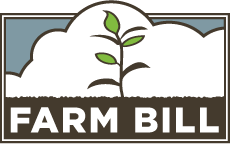CDFA is in the midst of preparing California’s recommendations for the 2018 Farm Bill. The Farm Bill is renewed every five years and serves as the policy guideline for food and farming in the United States. The legislation touches all of us in numerous ways, as this series of blog posts explains in greater detail.
When first passed in 1933, the Farm Bill (then known as the Agricultural Adjustment Act) was designed to incentivize struggling growers to produce more food for Americans suffering from the Great Depression. Although that time has long since passed, America’s farmers and ranchers continue to face challenges ranging from volatile market prices to erratic weather patterns.
Take, for example, California’s historic drought: according to economic analyses conducted by UC Davis, California’s drought caused $5.6 billion in losses to the state’s agricultural economy in its final three years. For California’s farmers and ranchers, the farm bill not only provides a healthy safety net, but more importantly, peace of mind.
Specifically, three titles within the Farm Bill help create a strong safety net for our farmers and ranchers: commodities, crop insurance and trade.
Safety Net – Commodity and Insurance
The 2014 Farm Bill brought wholesale changes to programs that support traditional commodity crops. Under the 2014 legislation, both Direct Payments and Average Crop Revenue Election programs were replaced with two new programs: Price Loss Coverage (PLC), which makes payments to growers when the price of covered crops drop below a government set reference price; and Agricultural Risk Coverage (ARC), which covers a farmer’s out-of-pocket loss when revenue declines. Additionally, under the 2014 bill, growers gained the ability to choose between both.
For Californians, the Farm Bill commodity programs need to cast a wider net. California’s unmatched range of crops means that many of our commodities do not fall under typical Farm Bill titles, so they do not qualify for insurance or commodity support. A future Farm Bill should look to expand these definitions to include the diversity of crops grown in California.
Trade
As the world’s fifth-largest supplier of food, California’s agriculture sector is a primary player in global trade. In 2015, California exported approximately 26 percent of its agricultural production by volume, at a value of more than $20 billion. Significantly, California is the nation’s sole exporter of many agricultural commodities. We supply 99 percent or more of the following crops: almonds, artichokes, dates, dried plums, figs, garlic, kiwifruit, olives and olive oil, pistachios, raisins, table grapes, and walnuts.
In order to continue providing our high-quality products abroad, California farmers and ranchers rely on several trade/food supply related programs, including the Market Access Program (MAP), Foreign Market Development Program (FMDP), Emerging Markets Program (EMP) and Technical Assistance for Specialty Crops (TASC) program. A future Farm Bill should continue to support these trade programs to ensure equitable trade and global access for our farmers and ranchers.



